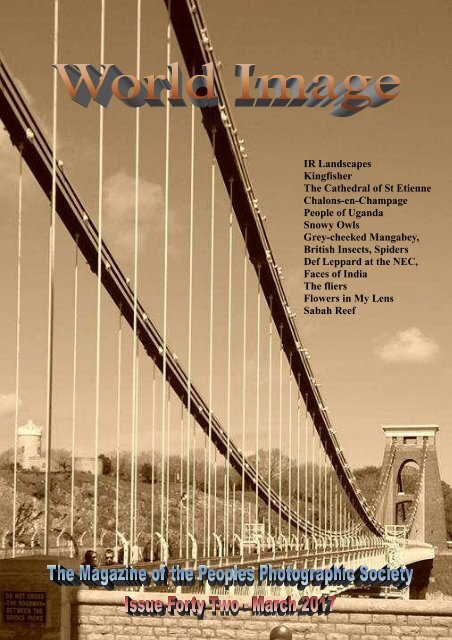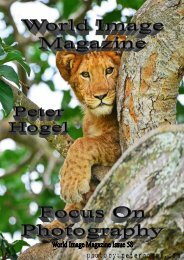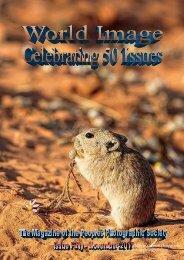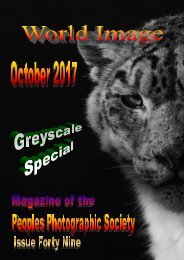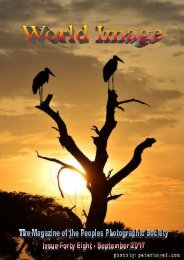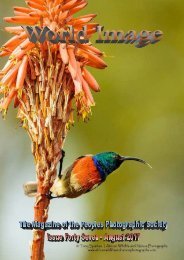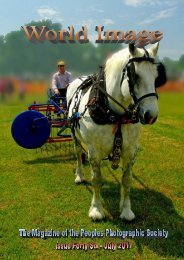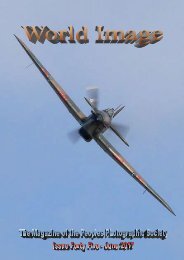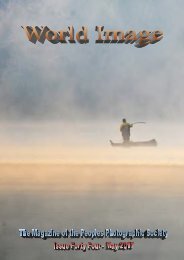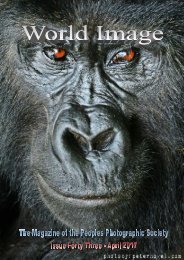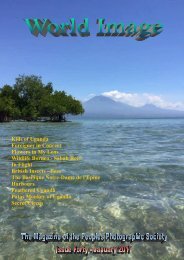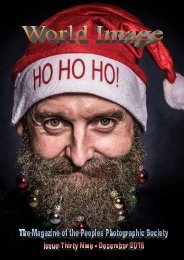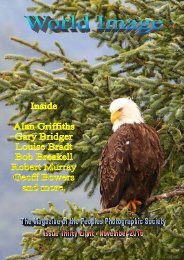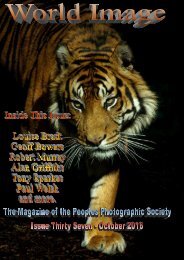World Image Issue 42 March 2017
World Image Magazine began as the journal of the Peoples Photographic Society, and, while the Society continues, the magazine has become an entity in its own right with contributions from Society members and non members with an interest in promoting photography that i8s attainable to everyone not just the elite of the publishing world.
World Image Magazine began as the journal of the Peoples Photographic Society, and, while the Society continues, the magazine has become an entity in its own right with contributions from Society members and non members with an interest in promoting photography that i8s attainable to everyone not just the elite of the publishing world.
You also want an ePaper? Increase the reach of your titles
YUMPU automatically turns print PDFs into web optimized ePapers that Google loves.
IR Landscapes<br />
Kingfisher<br />
The Cathedral of St Etienne<br />
Chalons-en-Champage<br />
People of Uganda<br />
Snowy Owls<br />
Grey-cheeked Mangabey,<br />
British Insects, Spiders<br />
Def Leppard at the NEC,<br />
Faces of India<br />
The fliers<br />
Flowers in My Lens<br />
Sabah Reef<br />
Website = photosociety.net Page 1 email = magazine@photosociety.net
Gordon Longmead - England - CEO<br />
Peter Hogel - Uganda - Deputy CEO<br />
Scott Hurd - Namibia<br />
Tom Coetzee - South Africa<br />
Paul Welch—Australia<br />
National and Regional Management<br />
Steve Cook - USA<br />
Robert Murray - Scotland<br />
Tina Andreasson - Sweden and Mexico<br />
Jack Glisson - Kentucky USA<br />
Contents:<br />
3 Photo Spot Tony Sparkes<br />
4 The River Great Ouse, Cambridgeshire - Norfolk Border<br />
6 Wildlife Borneo - Sabah Reef by Gary Bridger<br />
8 A Study in Greyscale - People Pictures by Alan Griffiths<br />
9 A Study in Nature - Little Owl, (Athene noctua) - Scott Latham<br />
10 The Magazine HQ has moved or The Things We Do For Photography<br />
12 People of Uganda by Peter Hogel<br />
16 Langford Lowfields RSPB site by Geoff Bowers<br />
17 Laon Cathedral by Geoff Bowers<br />
18 Photo Spot by Nam Prasad Satsangi<br />
20 Europe at Wolverhampton 15/4/14 Pictures by Alan Griffiths<br />
22 Flowers in my Lens by Gordon Longmead<br />
26 Photo Spot by Geoff Bowers<br />
28 The Things We Do For Photography Pt 2<br />
31 Photo Spot by Georgene Bergstrom and Nam Prasad Satsangi<br />
32 Mushrooms and Toadstools by Gordon Longmead<br />
36 Wildlife of America - No Names, No Quackdrill by Larry Hitchins<br />
37 Feathered Uganda Pictures by Gordon Longmead<br />
Cover picture - Clifton Suspension Bridge by Matthew Brooks<br />
Website = photosociety.net Page 2 email = magazine@photosociety.net
I often find the simplest and uncomplicated of compositions are pleasing to the eye and have good<br />
impact.<br />
Here an example of that. On quite a cool mornings game drive in Bundala National Park - Sri<br />
Lanka, this Spotted Dove (Stigmatopelia chinensis) gave a good clean composition and an<br />
intimation on how chilly it felt by puffing itself up a little...<br />
Tony Sparkes<br />
Website = photosociety.net Page 3 email = magazine@photosociety.net
The River Great Ouse, Camb<br />
Travelling back and forth along the A10 between my home and Downham Market in Norfolk, the route takes<br />
me alongside of the River Great Ouse. This is part of one of the longest canal systems in England which drains<br />
into the Wash at Kings Lynn in Norfolk. Most of the time when travelling to Downham, I am on a tight time<br />
limit, the lighting is wrong, or the lay-by is full. But today was different, today it was foggy, I still did not stop<br />
on the way out, but I took the opportunity to stop on the return journey. I wonder how many times people see<br />
the picture while going to a meeting when they can not stop, but forget that they can stop and enjoy the<br />
moment on the return home. On the way out the fog was thick with visibility down to a few hundred yards, by<br />
the time I returned the fog had lifted so I stopped to see what the view was like in the light mist. Well this was<br />
it. The sun was trying to break through so the lighting was changing from minute to minute, even on this day I<br />
was racing to get home before dark, half an hour later and the fog here had visibility down to a few hundred<br />
yards once again.<br />
The first image I usually try to get with landscapes is a series from which I can create the panorama. This is<br />
always a handheld series of images taken in rapid succession to keep the lighting stable. The sun is fickle and<br />
often will appear half way through the series just to spoil the final image.<br />
Website = photosociety.net Page 4 email = magazine@photosociety.net
- Norfolk Border<br />
Before anyone asks, landscapes are not my favourite subject, those I take tend to be record shots so I take very<br />
little time over them. Sometimes they actually work, if you take enough of them one might even be a stunning<br />
image, but just not today. Today is for the record, I will return at different times and under different conditions<br />
and will take the same sequence just for comparison.<br />
But in the picture above the boat caught my attention. The first in the sequence was taken from the same place<br />
as the panorama. The grey patch is a bed someone uses when the sun shines for relaxation, no good for a<br />
picture, so in the second image I walked along until I achieved some separation between it and the boat. The<br />
intention was to crop in later and remove the offending item, but when I tried it, it seriously unbalanced the<br />
picture. I was not deterred from the task, I had the result in mind and so I ’removed’ the offender in post<br />
processing, last image, I still refrained from cropping the image as I wanted the grasses in the foreground and<br />
to keep the building and power lines intact. Did it work? It did for me as it gave me the image I had in mind<br />
when I took the original picture, and that is what counts.<br />
Gordon Longmead<br />
Website = photosociety.net Page 5 email = magazine@photosociety.net
Wildlife Borneo - Another Day in Paradise 14<br />
Sabah Reef by Gary Bridger<br />
The underwater world of Sabah Reef is threatened by development and irresponsible tourism. Here is just a<br />
glimpse of the fragile beauty that may soon disappear.<br />
Website = photosociety.net Page 6 email = magazine@photosociety.net
Website = photosociety.net Page 7 email = magazine@photosociety.net
A Study in Greyscale - People<br />
Pictures by Alan Griffiths<br />
Website = photosociety.net Page 8 email = magazine@photosociety.net
A Study in Nature - Little Owl, (Athene noctua)<br />
Pictures by Scott Latham<br />
The little owl (Athene noctua) inhabits much of the<br />
temperate and warmer parts of Europe, Asia east to<br />
Korea, and north Africa. It was introduced into<br />
Britain at the end of the nineteenth century<br />
This owl is a member of the typical or true owl<br />
family, Strigidae, which contains most species of<br />
owl, the other grouping being the barn owls,<br />
Tytonidae.<br />
It is a small, cryptically coloured, mainly nocturnal<br />
species and is found in a range of habitats including<br />
farmland, woodland fringes, steppes and semideserts.<br />
It feeds on insects, earthworms, other<br />
invertebrates and small vertebrates.<br />
Males hold territories which they defend against<br />
intruders. This owl is a cavity nester and a clutch of<br />
about four eggs is laid in spring.<br />
The female does the incubation and the male brings<br />
food to the nest, first for the female and later for the<br />
newly hatched young. As the chicks grow, both<br />
parents hunt and bring them food, and the chicks<br />
leave the nest at about seven weeks of age.<br />
Little Owl with Prey (Athene noctua)<br />
Website = photosociety.net Page 9 email = magazine@photosociety.net
The Magazine HQ has moved.<br />
Or<br />
The Things We Do For Photography<br />
Part One - Introduction<br />
Over the last few magazines I have mentioned to our readers that I was in the process of moving house from<br />
my original base in Welwyn to a quieter location in Norfolk.<br />
That move has finally taken place, well almost, Wendy and I have moved in with June Smith (my mother<br />
and a non internet member of the Society), while we make our dream home and the new HQ habitable.<br />
Having already moved one lorry load of boxes by car, it still took another two loads in a 7.5 ton truck to get<br />
our accumulated furniture here. Just to set the scene and to give you an idea of the enormity of the task<br />
ahead of us. The cottage sits in 1/3rd of an acre of land, all of which will be landscaped into a disabled<br />
friendly wildlife and flower garden.<br />
We knew there were a few problems that needed sorting out before we exchanged, but it was only after<br />
buying that we discovered everything that was needed to be done. One of those turned out to be in our<br />
definite favour when we had the site officially measured. It turned out that a large area of land our<br />
neighbour believed he had purchased was actually ours, so the garden has been extended before we even<br />
started working on it. It will ultimately suit both ourselves and the neighbour as he wants to straighten the<br />
boundary and we want the longer garden, problems sorted.<br />
Having exchanged we went to the ‘cottage’ and started to discover new bits, like there is no water plumbed<br />
in, the existing being rendered unfit, no electricity in most of the property, half had been condemned and the<br />
cables cut through, the remainder was done by a fool with little or no concept of safe wiring, (never would I<br />
believe that a ring main could be installed using a 6amp breaker and 1.5mm wire). The boiler we knew did<br />
not work and would need replacing, so we had no heating. The whole system was on microbore tubing so<br />
we have decided to rip it all out, only then did we discover that all the pipes and electric cables had been<br />
cemented directly into the walls. As the cottage was built in 1875 I guessed that there was no damp proof<br />
membrane in the floor, this was confirmed when I ripped out some floorboards that had been laid in 1911<br />
(the carpenter had actually signed them).<br />
The snug did not appear to be a problem, the fancy fireplace was made from plasterboard and hid a larger<br />
fire opening so it was removed. That revealed woodworm, so the floor followed. Illuminating the inside<br />
revealed the extent of the damp. The ground under the floor is nothing more than fenland peat, and the holes<br />
within the surface of that were very deep and so had to be dealt with … Gordon style.<br />
Website = photosociety.net Page 10 email = magazine@photosociety.net
Although the fireplace is a Victorian original, it has suffered damage from attempts to ‘improve’ the house<br />
by a very bad DIYer, so it needs work but we have plans. We want to retain some of the character while<br />
creating an outstandingly well decorated room. Will we succeed ? Well by the time I write part three it<br />
should be done apart from the wall paper and carpets. An attempt to install a DPC into the wall had been<br />
made, you can see the row of new bricks on the left in this picture. They stand on top of the DPC. But, as<br />
the walls are solid, (no cavity), it was a daft attempt. The rising damp simply went up the outside and<br />
crossed to the inner walls. This was made worse by the installation of two steps to the front door that<br />
allowed the water to penetrate above the DPC, and an insubstantial guttering. This item is currently being<br />
replaced during the refurb of the adjacent property, at the same time the chimney stacks are being renovated.<br />
So the tasks were mounting up. The whole of the ‘snug’ floor will be removed and the inside of the walls<br />
painted with damp proofing paint, this will be covered inside with roofing felt, battened and insulated before<br />
fixing the plasterboard. The floor will be brought up to level using 20 tons of oversite onto which we will<br />
add a full DPC, 75mm insulation blocks, a 100mm of reinforced concrete screed, 20mm battens with further<br />
insulation to support timber floor panels, topped with underlay and carpet. Unfortunately an injury means<br />
this remaining load will have to wait until I am allowed to walk again. There are another 4 rooms and three<br />
sheds to do in the same manner which will involve the delivery of another 60 tons … lovely.<br />
The aforementioned steps will be removed and a covered reception area will be erected. The main roof<br />
guttering is also being replaced and that combination should stop the damp getting in. Just to make sure we<br />
are installing a multifuel burner in the snug room although we are retaining the existing fireplace in its<br />
original Victorian form, but with a complimentary modernish cladding and fire surround to the damaged<br />
sections of the stack. The room will be completed with subdued lighting to enhance the atmosphere. We<br />
intend take the same process to all the other downstairs rooms before replacing the stairs and upstairs floors.<br />
We also intend to change the upstairs layout as we go to suit our needs.<br />
Once the snug is complete, but before the decorating and carpets are installed, all the furniture will be<br />
moved into the new room, and the two ‘non-standard’ rooms and the mobile home will be removed and<br />
burnt, a new door will be installed to the side (and the front door will be replaced). This will provide better<br />
access to the rear garden and will eventually become a car port.<br />
Once the rebuild of the cottage is complete, the utility room and conservatory will be replaced with a single<br />
conservatory although there is an ongoing discussion about extending the existing kitchen. The roof space<br />
will be insulated and boarded out with the possible addition of solar panels to power the house/garden<br />
lighting which will be installed.<br />
While one garden building has already been repaired to a habitable state, (the bird box was falling from the<br />
tree), the other existing garden buildings are to be demolished and replaced with larger and more substantial<br />
ones to provide social space, along with my new greenhouse and tool shed. The whole area is to be<br />
monitored by cameras, partly for security, but mainly to monitor the wildlife, of which there is an<br />
abundance.<br />
Once we get this completed, (most of it at least), Photo Society members will be invited to visit to indulge<br />
in the photography of said wildlife, and the wildlife and landscapes of the many canals and rivers that adorn<br />
the Fens round about. The nearest being just 100 meters away. For those who want to indulge in more<br />
comfort than we may have to offer, there is a small hotel a short distance away.<br />
This is just an outline of what we are tackling. The February report can be see later in the magazine and<br />
from next month I will be reporting each months progress, I may even get chance to bring you some of the<br />
local wildlife.<br />
Gordon<br />
Website = photosociety.net Page 11 email = magazine@photosociety.net
Website = photosociety.net Page 12 email = magazine@photosociety.net
Website = photosociety.net Page 13 email = magazine@photosociety.net
Website = photosociety.net Page 14 email = magazine@photosociety.net
Website = photosociety.net Page 15 email = magazine@photosociety.net
Continuing the story, there are birds at Langford Lowfields,<br />
over 190 species of them, but there is also a wide variety of<br />
other species of which nature is so fond of establishing, with<br />
or without human help.<br />
The flower and fungi seeds that lay dormant in the soil,<br />
sometimes for decades, find themselves near the surface<br />
once again after the earth has been disturbed. More seeds are<br />
brought in by the birds and the winds, and suddenly the<br />
ground springs to life in a carpet of colour.<br />
The water attracts the birds and dragonfly, and the flowers<br />
attract more insects, until the area becomes a riot of sound<br />
and colour.<br />
Website = photosociety.net Page 16 email = magazine@photosociety.net
Laon Cathedral dates from the 12th century and is an early example<br />
of the Gothic style. The former cathedral was burned during an<br />
insurrection in 1112. The reconstruction began in about 1160 and<br />
was finished as far as the east side of the transept by 1174. the<br />
rebuilding continued between 1180 and 1205. The final stage being<br />
started in 1215.<br />
Website = photosociety.net Page 17 email = magazine@photosociety.net
Bulbul by Nam Prasad Satsangi<br />
Common yellow Grass was shot at Nunmanglam Reserve forest. Picture by Nam Prasad Satsangi<br />
Website = photosociety.net Page 18 email = magazine@photosociety.net
Music all the way by Nam Prasad Satsangi<br />
Leopard at Nadutu Tanzania by Nam Prasad Satsangi<br />
Website = photosociety.net Page 19 email = magazine@photosociety.net
Europe appearing at Wolverhampton 15/4/14<br />
Pictures by Alan Griffiths<br />
Europe is a Swedish rock band formed in Upplands Väsby, Stockholm in 1979 under the name Force by<br />
guitarist John Norum, vocalist Joey Tempest, bass guitarist Peter Olsson, and drummer Tony Reno. Since<br />
its formation, Europe has released ten studio albums, three live albums, three compilations and nineteen<br />
videos. The current members of the band include :<br />
Website = photosociety.net Page 20 email = magazine@photosociety.net
Joey Tempest - lead vocals, occasional guitars, keyboards and piano<br />
John Norum - guitars, backing vocals<br />
John Levén - bass, backing vocals<br />
Mic Michaeli - keyboards, piano, keytar, backing vocals, occasional guitars<br />
Ian Haugland - drums, percussion, snare drum, backing vocals<br />
Website = photosociety.net Page 21 email = magazine@photosociety.net
Website = photosociety.net Page 22 email = magazine@photosociety.net
Website = photosociety.net Page 23 email = magazine@photosociety.net
Website = photosociety.net Page 24 email = magazine@photosociety.net
Website = photosociety.net Page 25 email = magazine@photosociety.net
I unusually tried some mono in London by Geoff Bowers<br />
Website = photosociety.net Page 26 email = magazine@photosociety.net
sunset from a lay by on the A17 near Cranwell Geoff Bowers<br />
Website = photosociety.net Page 27 email = magazine@photosociety.net
The Things We Do For Photography Pt 2<br />
Part Two - Month One, February <strong>2017</strong><br />
For those who read the other article you will know what this is about. You may not understand how it relates<br />
to photography, it does, but in a peripheral context. The obvious connection is that as the person leading the<br />
charge with the Society and Magazine, I have moved to a new county.<br />
In that regard, the HQ of the aforementioned Society and Magazine has<br />
also moved to the new venue. The not so obvious is to show that articles<br />
can be created on any subject by anyone. Not everyone will be interested<br />
in the subject matter but that is true of any article even those aimed<br />
directly at photographers.<br />
My / our new base sits in 1/3rd of an acre of land in the Norfolk Fens and<br />
is perfectly placed to indulge in the stunning landscapes and wildlife of<br />
the canals and coast of this area. It also caters for the steam railway<br />
enthusiasts with the Sheringham and Bressingham railway centers only a<br />
short distance away, and others further along the coast for visitors to<br />
enjoy.<br />
The wildlife in the area of the garden includes Kestrels, Barn Owls, gold<br />
finches, woodpeckers, many of the tit families including long tailed, blue<br />
and great. There is much more for me to find, and I will try to get the<br />
cameras operating between jobs to bring you some images.<br />
So having purchased our new base, the task of renovation was started. This involved gutting out the snug<br />
and removing all the floors and floor joists, many of which showed signs of woodworm infestation. We had<br />
not intended to do this as the floor from above looked ok, but the removal of the fire place revealed more<br />
than we expected.<br />
It all began with a survey of said fireplace to install a multifuel<br />
fire which showed that the small opening we could see hid the<br />
larger, original, Victorian fireplace behind. It was the removal<br />
of the newer, red painted, wood and plaster from the stack that<br />
revealed the first evidence of the woodworm. As that was the<br />
new addition it did not take much imagination to picture the<br />
state of the floor boards and joists.<br />
So the next step was to lift a few boards and look below. What<br />
a surprise, most of the floorboards were not damaged, as were<br />
many of the joists. These will be treated and reused …<br />
somewhere. Others were indeed infested and will be burnt.<br />
As you can see from the picture, they have all been removed and the fireplace exposed. The base has also<br />
gone and will be rebuilt to accommodate the hearth and fire.<br />
The radiators and electrics have also been removed, most should have been condemned when they were<br />
installed and the heating does not work anyway. My intention is to install all new wiring as we renovate each<br />
room and the central heating will be done last of all.<br />
Website = photosociety.net Page 28 email = magazine@photosociety.net
Removing the floor also revealed the ground below. There was no DPC and the ground was the dirt of the<br />
fens. The hole shown was one of many that went down to over a meter in depth. These were formed by<br />
underground water undermining the top and causing it to open the fissures. These have been re-compacted<br />
and covered with compacted oversite.<br />
As are a number of other trees that are diseased and dying.<br />
The only one that is safe is the silver birch which is protected<br />
by law.<br />
I briefly mentioned a slight accident which has had major<br />
consequences for me. One of the trees that was removed was<br />
covered in very long and equally sharp spines.<br />
These were all removed during felling, an easy matter of<br />
running your hand down the branch and they snapped off.<br />
Now this does not look like much, but 2 tons have been<br />
put into the foundation before I took this picture, and<br />
there is 18 tons remaining in the heap 10 tons of which<br />
will go into the floor.<br />
Of course the cottage is not the only part of this project,<br />
we also have the garden which we are working on when<br />
it is warm and the sun shines. As it is February that is not<br />
often so we must make the most of it when it does.<br />
The garden is bounded to the north and east by Leylandi<br />
conifers, the most antisocial tree ever introduced into the<br />
English landscape, so they are slowly being removed.<br />
Planning to leave for the day I removed the steel toe caped shoes and put on normal ones, then I decided to<br />
move a few more logs to the growing heap. With an armful of said logs I found one branch of the offending<br />
tree in my way and so, without thinking, kicked it to one side with my foot.<br />
I could have sworn that I had removed all the spines, but apparently not, one remained and my foot had<br />
found it. The spine penetrated the side of my shoe and passed deep into the big digit on the other side.<br />
I managed to pull it out from the shoe and most of the stub came with it so I figured all was well, we get<br />
splinters all the time and this was no different was it. Actually yes it was, within the hour my toe was<br />
swelling and turning a funny red colour.<br />
Website = photosociety.net Page 29 email = magazine@photosociety.net
By the following evening the foot had followed suit. A&E beckoned and they dressed it and gave me<br />
antibiotics.<br />
Ten days later the foot was still infected, but an ultrasound had been arranged so a return to the hospital was<br />
organised. The ultrasound took 15 minutes and showed debris in the wound, so I was sent directly back to<br />
A&E where, after 5 hours and a doctor trying to dig out the offender with scalpel and forceps, I was told an<br />
operation was needed to get to it.<br />
The operation was scheduled for two days later, arrival at the ward by 8am, surgery finally happened at 6pm<br />
and I was allowed to go home. Not allowed to walk on the foot for 3 days and no working on it for two<br />
weeks (yeh right).<br />
Now you may wonder why I have gone into so much detail on this, any one who has put a spine through the<br />
joint of their big toe will know just how painful it can be, but hey, I got the spike out. The culprit that has<br />
stopped me working at the cottage was a piece of wood 6mm in length that had broken in the toe and the<br />
sharp point was now facing the wrong way like the barb on a fish hook, and loaded with so much bacteria<br />
that antibiotics could not cope with it. Hopefully with the rubbish now removed my own bodies defences<br />
can now do the rest and let me get on with the job in hand.<br />
One other event was not quite as daft, but showed up the dangers of buying land with out getting a formal<br />
survey done against the land registry records. Our new neighbour did just that, taking the word of a former<br />
owner as to the position of the boundaries.<br />
On my part I am so glad I had the survey done on Lyndel as it showed that the boundary of our land actually<br />
took in much of his lands access drive, and an area of land the full width of our garden to a depth of 4<br />
meters to the rear which encompassed a double garage that had been erected there. Negotiations resulted in<br />
the access drive being widened and the equivalent square meters being added to the length of our property<br />
so everyone is happy (well almost).<br />
So building work on the cottage has almost come to a halt for this month, I will be pottering around doing<br />
odd jobs from a chair and a bit of work in the garden. Most of it will be directing my staff (Wendy) in her<br />
allotted tasks.<br />
We have planted the first apple tree in the new orchard, and started sorting the plants to tidy up the existing<br />
patio so that task will continue for the rest of February by which time I should be in action again. Meantime<br />
I will get the cameras out and indulge some wildlife photography and finishing this magazine.<br />
On a brighter note the main chimney has now been rebuilt and the other one has been removed. This work<br />
has been done by the owners of the adjoining cottage as they thought we may want to do both at the same<br />
time to reduce costs especially as he needed our permission to do the work. He is also having the guttering<br />
replaced and is arranging for ours to be completed at the same time.<br />
Gordon<br />
Website = photosociety.net Page 30 email = magazine@photosociety.net
Street photography - Skateboarder by Georgene Bergstrom<br />
Shot in the garden of my daughter Resham Bhatia at Adarsh Palm Meadows Banglore - Nam Prasad Satsangi<br />
Website = photosociety.net Page 31 email = magazine@photosociety.net
Website = photosociety.net Page 32 email = magazine@photosociety.net
Website = photosociety.net Page 33 email = magazine@photosociety.net
Website = photosociety.net Page 34 email = magazine@photosociety.net
Website = photosociety.net Page 35 email = magazine@photosociety.net
A Study in Nature<br />
Wildlife of America - No Names, No Quackdrill by Larry Hitchins<br />
Website = photosociety.net Page 36 email = magazine@photosociety.net
Feathered Uganda<br />
Pictures by Gordon Longmead<br />
Palm Nut Vulture<br />
Shoebill<br />
African Grey Hornbill<br />
Abyssinian Ground Hornbill (Bucorvus abyssinicus)<br />
Abyssinian Ground Hornbill (Bucorvus abyssinicus)<br />
Senegal Coucal<br />
White Browed Coucal<br />
Website = photosociety.net Page 37 email = magazine@photosociety.net
Kuyimba means 'to sing' in the<br />
Zambian Chinyanja language and<br />
this site is a celebration of the sights<br />
and sounds of southern Africa. Join<br />
us to experience it for yourself.<br />
Derek & Sarah Solomon<br />
www.kuyimba.com<br />
Website = photosociety.net Page 38 email = magazine@photosociety.net
We hope you like the magazine, the size and content of future issues depends on you.<br />
Submissions for the next issue are being accepted<br />
Website = photosociety.net Page 39 email = magazine@photosociety.net
Website = photosociety.net Page 40 email = magazine@photosociety.net


